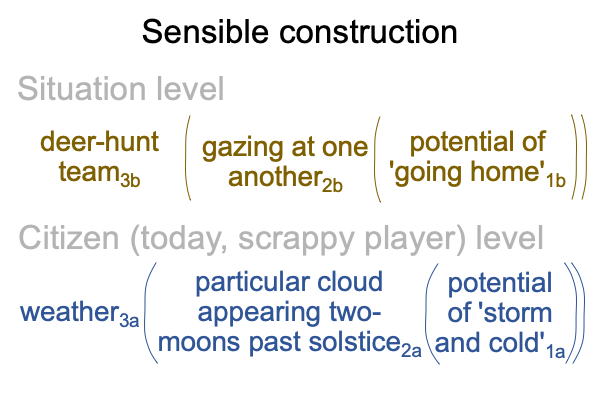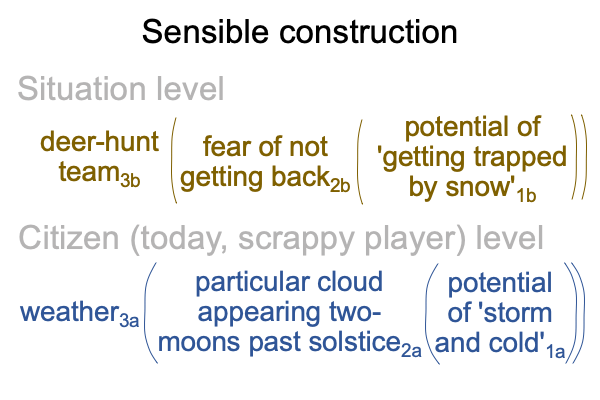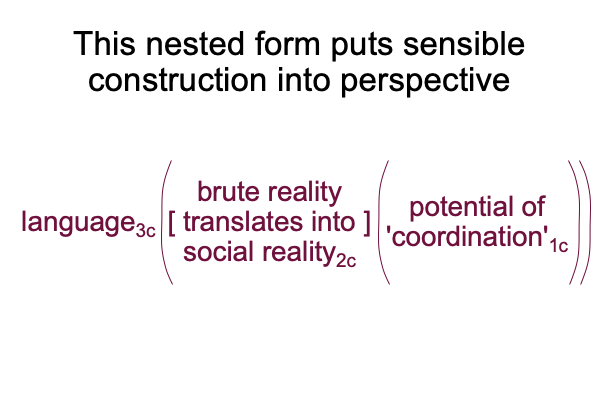0874 Technically, the social nested form virtually situates the physical nested form, producing the following two-level interscope. For details on nested forms, consider A Primer on the Category-Based Nested Form and A Primer on Sensible and Social Construction by Razie Mah, available at smashwords and other e-book venues.

Even though explicitly abstract terms enter into the empty slots of this two-level interscope, the overall structure keys into implicit abstraction. The slots of an implicit relational structure are filled with relevant explicit terms, through the method of association and implication.
Once an association is made, ask “What does that imply?”
0875 Chapter one of Enfield’s book is titled, “Coordinating around Reality”. It is the first chapter in Part I, titled, “Mapped by Language”.
The author tells the reader about Thomas Schelling’s psychological experiments, which found that people can often arrive at the same solution without speaking to one another. If visitors in two locations are given the same map of the city, they will meet at the one bridge, without even talking to one another.
Coordination has two implications. The first is shared attention. Michael Tomasello calls this “joint attention”. The second is a certain type of mind-reading, that may or may not rely on… um… “language”.
0876 Back to the ongoing example. If members of my team look at one another in angst, after I, the ad-hoc leader, point to a group of deer that we could drive over the cliff, then I may come to a judgment that I will express in hand talk. Let us go home. The brute reality of the implications of the cloud weighs against the social reality of what the team is supposed to accomplish.
0877 My judgment reflects the following sensible construction.

0878 The appearance of a particular cloud before the earliest fall storm is universal. It happens most every year. Everyone on the team has seen it in the past. Now, they see it again, the harbinger of the first snow.
Worrying about getting back from the hunt is intelligible. Everyone on the team knows it.
0879 However, in hand talk, there is no way to formulate the words, “universal” or “intelligible”.
What is there to picture or point to?
So, how does everyone on the team fixate, with the similar imaginations, onto the same situation-level potential?
0880 Are “universal” and “intelligible” adaptations, whereby physical universality… er… brute circumstances translate into social intelligibility… er… reality? Are the explicit abstractions of “physical reality” and “social reality” and “translates” built into our bodies and brains?
0881 The relational structure of sensible construction seems to provide an answer, in so far as my judgment is rendered using hand talk. So, I can say that the normal context of language3c brings the actuality of the physical reality of the impending storm [translates into] the social reality of returning empty-handed from the deer hunt2c into relation with the potential of coordination1c.

0882 Yes, the above nested form puts sensible construction into perspective.
But, it cannot be rendered using hand-talk.
Indeed, this nested form lassoes the explicit distinction that Enfield casts in his introduction and places it as the actuality of an implicit perspective-level structure. If brute reality2c is universal, then social reality2c better be intelligible, because intelligibility and universality emerge from and situate the potential of working together in order to survive1c. Yet, even that potential1c requires a normal context, which I would call “talk3c“, but Enfield calls “language3c“.
